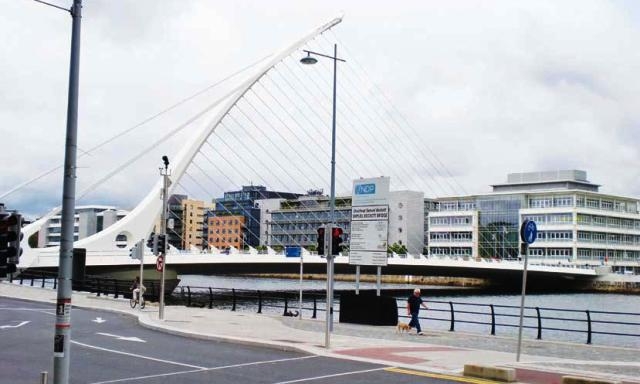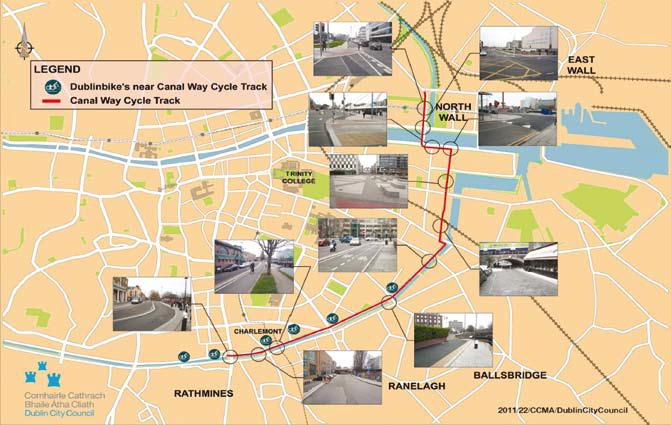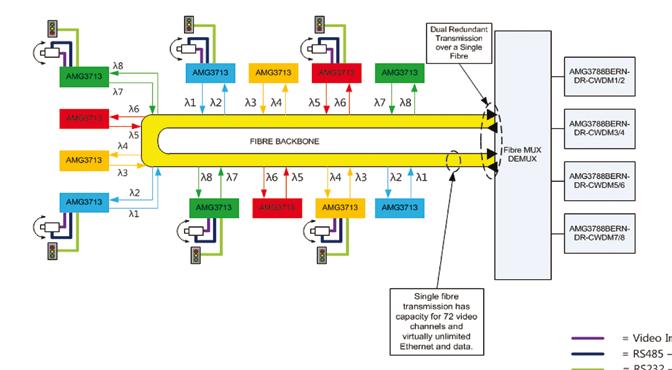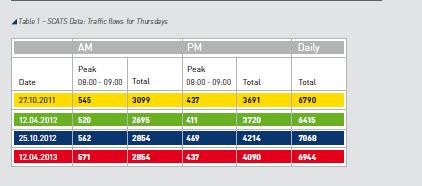Canal Way Cycle Route - A Premium approach to Cycle provision
By Brendan O’Brien MSc BSc Dip I.T. - Head of Technical Services (Traffic Dublin)
Dublin City Council vision for Dublin is to make it a city where people of all ages and abilities have the confidence, incentive and facilities to cycle. Numerous on road cycle lanes have been incorporated into designs for Quality Bus Corridors (QBCs) as well as a mix of on road and off road cycle routes. However, in 2010 Dublin City Council, with funding from the Department of Transport, began work on a new way of providing cycle facilities.
The Canal Way cycle route is an ambitious plan to provide an off road, mainly segregated 2 way Cycle Route, along the two canals which encircle the centre of Dublin. The Royal Canal on the Northside of the liffey and the Grand Canal on the South with the link between the two being the iconic Samuel Beckett Bridge.
3.6 km of phase 1 of the project was opened in 2012 with phases 2 and 3 now moving from design to Construction over 2014. These canals stretches a combined distance of 275kms from Dublin through the midlands of Ireland to the Shannon river, and some cycle routes have already been provided along the length of the canals with more in design.
The route has been designed to separate the cyclists from general traffic and pedestrians by providing kerbs along the cycle path. Hence, it is not a shared pedestrian and cycle route. This means, that cyclists are treated in the same fashion as any other stream of traffic.
This route is designed to be used by everyone from novice cyclists to the commuter cyclist. Because of the scenic nature of the route it is used as much at the weekend as during the week. It provides an important commuter cycle route from the main radial routes into the Docklands area - which is home to major Financial Services companies and a number of IT companies such as Google. It also links six Dublin Bike stations, making use of this route very easy for both workers and tourists alike.
The requirements to treat the route as a separate traffic route along its length and not share its facilities meant that the standard approach which DCC used on Quality Bus Corridors (QBC) was adopted. Namely, along its length any existing traffic signals should be upgraded and separate bicycle detection was required at each junction. As a sign of this, no cyclist buttons are used along its length. Instead loop detection and stop-line Video detection are used. Each junction was equipped with dedicated Bicycle detection at traffic signals, separate phases for bicycles with 100 mm cycle heads and with a new type of signalling to resolve Bicycle and Pedestrian Interaction at traffic signals along the route. At each junction, CCTV was to be provided, to allow traffic management, as well as to provide an element of security. All DCC Traffic cameras are shared in real time with the Irish Police.
Dublin is a radial city with multiple major traffic routes crossing the Canal Way. Hence, the issue of how best to provide for a cycle track crossing these major junctions was a major design issue. Along much of the route the Canal Way is located on the canal side, which did not have an existing continuous traffic route, and some major works had to be completed -including the provision of a boardwalk cantilevered over part of the canal - where the space on the existing path was inadequate - to avoid cycle /Pedestrian shared space.
(Example of Boardwalk where pedestrian provision is cantilevered over Canal )
The primary objective of the design was to ensure that cyclists would be treated in the same manner as road traffic (cars and trucks), by providing dedicated cycle phases in the traffic signal sequence or in other words Toucan crossings would not be used. However, at a number of locations no traffic signals existed at the Canal Way side of the junction and had to be installed, and in other cases the problem of fitting the Canal Way phase into an already complex sequence, was a major challenge.
At each crossing point a wrap around pedestrian phase was introduced, followed by a cycle phase. In order to minimise conflict between pedestrians and cyclists, and to eliminate cyclists having to cycle over tactile paving, the waiting areas for pedestrians and cyclist were segregated. The provision of a continuous cycle track across junctions eliminates the need for tactile paving across the cycle track.
The junctions on the Canal Way are predominantly four arm layouts, with heavy pedestrian, cycle and vehicle numbers in both radial and orbital directions. A 2012 count showed that during the peak hour, about 800 pedestrians and 550 cyclists use each junction. A new sequence for these junctions - called a nested Pelican - was introduced. This means that during the flashing green man, cyclists were provided with a flashing amber signal. Legislation was introduced to allow this type of operation with the legal requirement for cyclist to give way to pedestrians during this part of the sequence. The flashing amber for cyclists was then followed by a separate green cycle signal to ensure that cyclists could safely cross, even if there was heavy pedestrian flows – as is the case at many of the crossings.
At each crossing point, the cycle way was provided with dedicated 100 mm signals (see image below), and in many cases, due to space constraints, the primary signal for the adjacent traffic lane was mounted on a Cantilever pole in addition to highlight the separate nature of the route Stainless steel Traffic Signal poles were used for the Cycle track arms of the junction only.
(Two way cycle track with cycle heads and cantilever pole for general traffic, note the segregated waiting areas for cyclists and pedestrians )
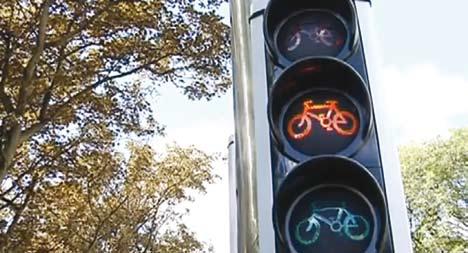
Dublin uses the Australian SCATS Adaptive traffic control system, and along this route the majority of the controllers would have already been connected to the SCATS system and as part of this project all controllers New and existing were to be added to the Fibre Optic Communications network. Therefore one of the first decisions made, was to provide longitudinal ducting along the route to allow for Fibre Optic cable to connect all of the ITS infrastructure, which is to be used on this phase and to allow for extension over all the phases of the Canal Way.
Dublin City Council’s Traffic Department has installed a dedicated fibre optic network around the City with multiple separate rings radiating from the Traffic Control Centre in the City Centre, and the Canal Route was linked in to this network at a number of separate points to allow for complete dual redundancy of the solution. In total in phase 1 22 Junctions or Pedestrian Controllers were connected to this fibre network along with 16 Cameras.
Most of the 240 Traffic cameras which DCC Traffic use are analogue with multiple Fibre optic networks providing the main communication network for both CCTV and Traffic Controller Communications. At the Traffic centre the CCTV signals are split with one input going into an analogue matrix and the other being converted into an IP stream for the Secondary Digital IP matrix. This provides maximum flexibility for distribution while ensuring that the CCTV images are available at the in-station without any compression loss and simplifying network security issues by not providing IP access points at the field equipment.
What was required, therefore, was a technical solution which would allow us to connect multiple CCTV and Traffic Controllers along the route, provide dual redundancy and allow us to expand the system as further parts of the Canal Way were added to the System.
The solution chosen was the AMG 3700 series, which has been used extensively by DCC for a number of years, and which provides the necessary features for this project.
The 3700 is configured in an 8 channel drop and insert configuration over a single Fibre providing 8 insert points along the route and providing a single CCTV input, plus a bi- directional data channel configured for RS 232 . The RS 232 is connected directly to the Traffic controllers on the SCATS AUTC system and at the in-station, this allows connection to the SCATS Hardware via DIGI C/Con 16 multi channel serial adaptors. Because the system provides a point-to-point channel at each location, the in-station provides 8 separate bidirectional channels with RS 232 interfaces. Enabling the Traffic controller and the CCTV to be brought back on the same system, maximises the effectiveness of the system. In addition, a 100 mbits Ethernet connection is available at each node for future use. The 3700 also provides a CWDM transmission solution which allows up to 72 analogue cameras to be collected onto a single fibre. The dual redundancy means that in case of a fibre failure or node failure, the system will immediately re-route and maintain operation. The Network Management system reports fibre failures and node failures immediate via SNMP, notifying the exact location of the problem. An added advantage of this is that the Network Management software provided for the 3700 links directly to the DCC Fault Management System allowing automatic notification and identification of faults.
At each out-station the 3700 unit has provision for one standard CCTV connection and a point-to-point data channel. In Dublin, the data channel is used in a point-to-point mode to allow Traffic Signal Controller communications to the SCATS Traffic control system, thus in each ring there is provision for 8 CCTV connections and 8 RS 232 point to point connections.
The 3700 series provides zero control latency and uncompressed digital transmission thus ensuring the image received at the Traffic Control centre can be used for multiple applications including video analysis.
Three 8 Channel 3700 receivers were used at DCC Traffic Centre, with provision for more to be added as required, and only three fibre cores of the fibre laid along the length of the cycle route was utilised to provide connectivity for up to 24 Cameras and 24 ( or 48 ) Traffic Controllers depending on board type.
Traffic Signals and Bicycle Counts
All the junctions that are under control of the SCATS AUTC system have phase sequences that are demand dependent. Accurate detection of vehicles at these junctions is essential, both to demand the correct phase, and to provide the AUTC system with the correct detection information to maximise the performance of the junction - and optimise traffic flow. Accurate and reliable detection facilitates collection of real time information for developing models for cyclists, and as this route is segregated it provides very accurate data.
The detection of cars and other large road vehicles is a tried and proven technology but the reliable detection of bicycles is more difficult. However, bicycle rims lend themselves well to detection by inductive loop detectors as the rim is close to the ground where the loop wires are, as shown in figure 8. In the design of the Canal Way signalised junctions, a decision was made to make the bicycle phase demand dependant, and vehicle actuated. The provision of loop detection connected to the Traffic controller also provides for accurate real time counts of bicycles and access to this data both in real time and using the integrated reporting tools in the SCATS system. A diagonal quadrupole loop configuration was used which is designed to have the loop at an angle, across the width of the cycle lane, ensuring reliable detection. In practice this has proven to be the case, with measured 100% detection when the bicycle crosses the loop.
In order to detect carbon fibre bicycle wheels, inductive loop detection is supplemented with above ground video detection that utilises a stereoscopic video camera to eliminate false detection from objects moving close to the ground. These units are designed for above ground pedestrian presence detection. In practice it was found that they could successfully detect bicycles in a 3m2 detection zone at the bicycle stop line, whilst their directional qualities avoided the detection of pedestrians crossing at the bicycle stop line.
( Graph of Bi-directional volume of cyclists. Note the tidal nature of the peaks indicating the high usage of the route for work purposes )
( Weekend usage of the cycle route but still with some tidal elements.)
Table 1 is an extract from SCATS Data and shows that the peak hour traffic volumes have not reduced as a result of introducing the cyclist phase in the signals sequence. In addition, the lane capacity, as calculated by the SCATS system, has not decreased due to introduction of the cycling facility, with lane capacities varying from 1420 to 1620 vehicles per lane per hour. SCATS Count Data for actual flows is shown in Table 1.
Table 1 – SCATS Data: Traffic flows for Thursdays
Monitoring
Sections of the route became available to cyclists from the autumn of 2011 and the route was fully opened on 22nd March 2012. Since then, the daily average has shown over 3,000 cyclists using this route with a 22% increase in 2013.
The operation of the nested pelican signal sequence is new to Ireland. As a result, in addition to standard road safety audits an additional safety assessment (Project Report CPR2044) was carried out to assess the safety of the signal sequence prior to first operation. The assessment concluded that there was nothing inherently dangerous with the proposed signal sequence. However, additional monitoring was required after the junctions had been operational.
Another survey (Project Report RPN2347) was carried out six months after opening, utilising cameras to record road user behaviour, as well as a questionnaires for pedestrians and cyclists, to determine road user perception on the new junction layouts and signal sequences. Preliminary results from this assessment suggest that over 90% of cyclists perceive the operation of the junctions to be satisfactory. In addition, over 90% of pedestrians had a preference for the new junction layout. The main reason given by 70% of those who preferred the new junction layout was that it is safer. Approximately 15% of pedestrians said they now walk more, with about 60% of those stating that it was because it felt safer. However, 10% of pedestrians interviewed considered the junction layout and signals as hard to understand.
In order to gauge weekend use, results from a survey carried out on a Sunday (Project Report RPN2347) show that 57% of cyclists use the route once a week or less, while 35% of pedestrians use the route for fun. On the other hand 85% of respondents to a survey carried out on a Thursday use the route for business related activities. It has also been observed that the route is well used by Dublin Bike users showing the added value of linking the bike stations along this route.
Conclusions
The first Phase of the Canal Way route has proven very popular with cyclists and has demonstrated that a high quality route will attract additional cyclists. It is also interesting to note that the existing cycle numbers on adjacent roads have remained very similar. The use of a range of ITS equipment - not normally used on cycle tracks - such as CCTV, Video and Bicyle Loop detection has proved its value, and enabled the cycle route to be treated as a major traffic route.
The use of multiple drop and insert Fibre optic rings has provided substantial benefits with adjacent junctions being converted from Leased line to Fibre and additional CCTV coverage provided both for safety and Traffic monitoring. Following on from this success, the next elements of the Canal Way in design, and moving to construction, will be provided with the same elements in a uniform design.


